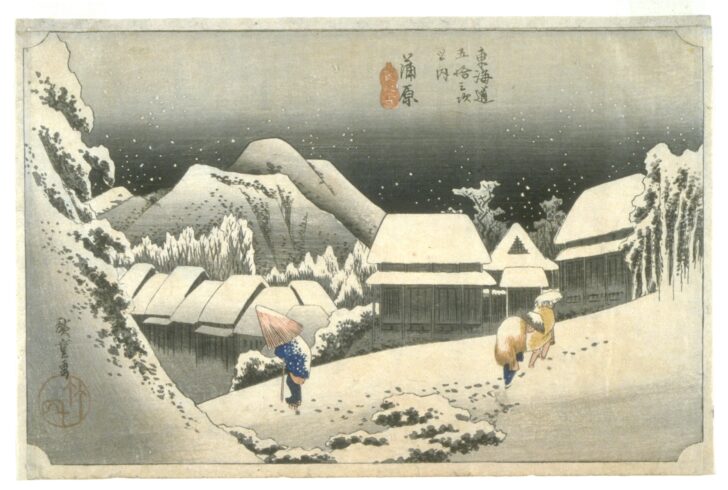The Fifty-Three Stations of the Tôkaidô (Hôeidô edition): #16 Night Snow at Kambara
Utagawa Hiroshige

Description
Among many series depicting the Tôkaidô Road, the Hôeidô edition was the first and considered the masterpiece. Hiroshige’s sophisticated use of soft lines, rounded forms, dark sky, and subtle tones convey the utter silence and weariness of the figures, making this one of the artist’s finest works among the fifty-five prints in this popular series.
UMMA owns four impressions of this print, none from the first impression. Each is different, with variations resulting from different manipulations of the same block, revealing both the skill and taste of the printmaker. In the case of Night Snow at Kambara, we know that the first impression has a heavily inked area at the upper portion of the sky. Here, the printer wiped off part of the dark pigment to prevent the dark sky from obscuring the title of the work, thereby lessening the dramatic effect somewhat.
exhibited summer 2010
Hiroshige is often considered the master of landscape prints. The Fifty-three Stations of the Eastern Sea Route series, to which this print belongs, made him famous. The Tokaido, or "Eastern Sea Route," stretched from Edo (present day Tokyo) to Kyoto with fifty-three stopping places. Hiroshige's sophisticated use of soft lines, rounded forms, dark sky, and subtle tones convey the utter silence and weariness of the figures, making this one of the artist's finest works.
The Museum owns four impressions of this print, none from the first impression. Variations came from manipulations of the same blocks, depending upon the skill and taste of the printer. In this case, the first impression has a heavily inked area at the upper portion of the sky. Wiping off part of the darker pigment, the printer created the gradation effect. Had the dark sky descended too far, the title would have been covered. The sky appears only in a flat grey that reduces the dramatic effect.
During the second or third impression the printer remedied this effect by moving the heavily inked area to the lower portion behind the hills and trees, creating a far more impressive night scene with a stronger contrast. While the original first impression has sharper lines, the alternative impression is more dramatic for reproduction.
Of the Museum's four prints, 1948/1.122 is the earliest impression, followed by .124 and .123. In the latest version, .125, the troublesome gradations are almost omitted, with the sky appearing only in flat gray. By this time, however, the original blocks were no longer complete, and the footprints totally disappeared, greatly reducing both the snow and night effects.
Subject Matter:
The scene conveys a sense of silence, and weariness. The mountain village at nightfall is slowly buried by a steady snow fall, and three people trudge through the snow, leaving footprints, one with his head covered by a half open umbrella, burdened by the weight of the cold and snow.
Physical Description:
In this print, sophisticated use of soft lines, rounded forms, dark sky, and subtle tones convey the utter silence and weariness of the figures as they trudge through the night-time snow near Kambara. Writing is centered at the top of the image, as well as aloong the bottom left wide with a seal. Three figures walk through the snow.
Usage Rights:
If you are interested in using an image for a publication, please visit https://umma.umich.edu/request-image/ for more information and to fill out the online Image Rights and Reproductions Request Form.